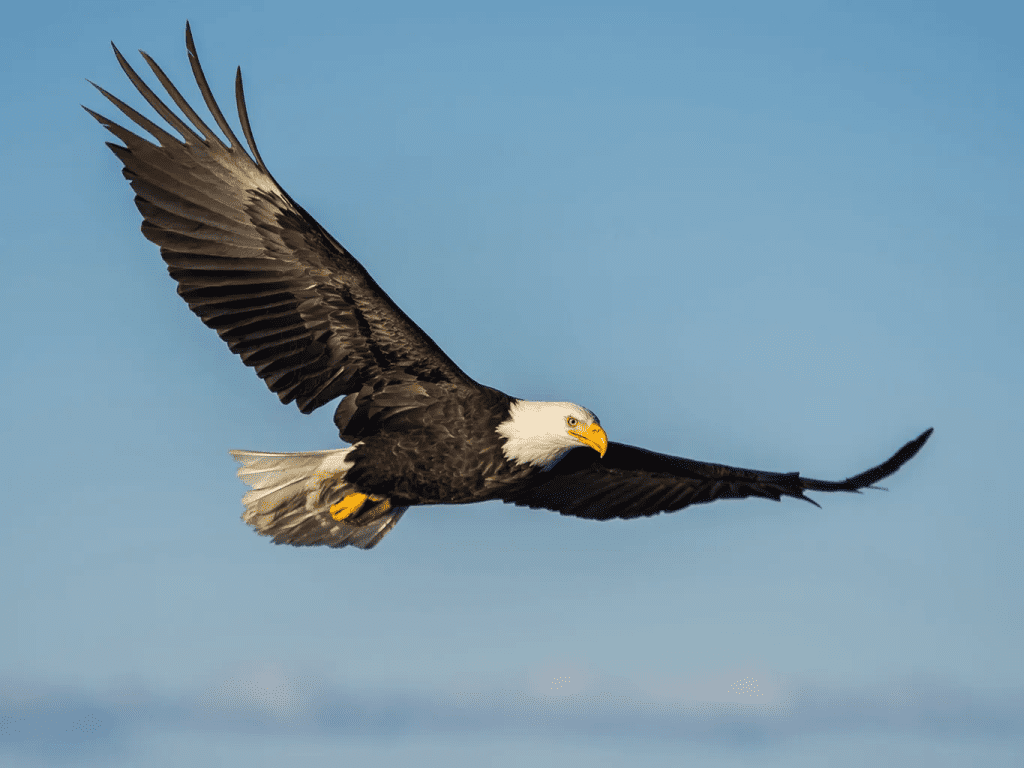Ever wondered how an eagle can swoop down from the sky and snatch a fish right out of the water with flawless precision? It’s not just skill — it’s next-level eyesight. Eagles are like flying cameras, equipped with ultra-high-definition vision that puts modern drone tech to shame.
These majestic birds don’t just glide through the air — they hunt with purpose. Their eyes are designed for the skies, and when you learn just how powerful their vision really is, it’s hard not to be amazed.
Eagle Vision: Better Than 20/20

Most humans consider 20/20 vision to be perfect. But eagles? They blow that out of the water.
Eagles are believed to have 20/5 vision, meaning they can see from 20 feet away what a human would only see clearly at 5 feet. That’s four times sharper than our best natural vision. This insane clarity allows them to pick up details we’d miss entirely — like a small fish flicking near the surface of a river, all from hundreds of feet in the air.
Imagine being able to spot a coin on the ground while standing on top of a 10-story building — that’s the eagle’s world.
Glare? Not a Problem for Eagles
Now, let’s talk about water. Even on a sunny day, the surface of a lake or river can be like a mirror — filled with glare and reflection. For us, it’s tough to see past it. But for eagles?
Their eyes are naturally equipped to filter out glare. They have a special structure in their retina that reduces the interference caused by reflected light, allowing them to cut through brightness and focus on movement beneath the surface. It’s like wearing polarized sunglasses — except built-in, and way more advanced.
Video : The Incredible Eyesight of Eagles: Nature’s Sharpest Vision
So while we might squint at a shiny lake, an eagle is already locked on to lunch.
Binocular Vision That Tracks Targets Mid-Air
You’ve probably heard the term “binocular vision” before — it’s what allows animals (and humans) to judge distance. Eagles have this too, but with a supercharged twist.
Their eyes face slightly forward, giving them excellent depth perception. And because they can move their heads smoothly while keeping their eyes locked on a target, they maintain laser focus even during high-speed dives. That means they can:
- Track a moving fish
- Calculate the angle of attack
- Time their dive to the millisecond
No second guesses. No hesitation. Just pure precision.
A Wide-Angle Field of View Without Losing Detail
Another wild fact? Eagles have a field of view of about 340 degrees — nearly a full circle. Yet somehow, they manage to maintain pinpoint detail in their central vision.
Their retinas are loaded with cone cells, which detect fine details and colors. This gives them a massive advantage: they can scan a huge area while simultaneously zooming in on one moving object. It’s like having both a panoramic lens and a telephoto lens active at the same time.
While you’re blinking at a blurry bird in the sky, the eagle already sees you — and probably knows what brand of hat you’re wearing.
How Eagles Use Vision to Hunt

Let’s break it down. Picture an eagle flying 300 feet above a river. It’s calm, quiet, and the water’s shimmering. Then, with almost no warning, the eagle changes course. Its wings pull in tight, and it drops like a missile.
Why? Because its eyes just caught a tiny flash beneath the surface — a fish swimming near the top.
The eagle:
- Adjusts its position mid-flight
- Times its dive perfectly
- Uses its talons to grab the fish — often without getting fully wet
This all happens in seconds. And it all begins with a flash of movement that you and I wouldn’t even notice.
Evolution Built the Ultimate Predator’s Eye
Eagles didn’t just wake up one day with superhero vision. This visual power is the result of millions of years of evolution, fine-tuned for survival.
Their eyesight helps them:
- Hunt more efficiently
- Avoid threats
- Navigate wide territories with ease

In the wild, vision is survival, and eagles have mastered that art. From open skies to dense forests, they rely on their vision more than anything else. It’s their secret weapon — and honestly, their superpower.
How Eagles Compare to Human Technology
Think your 4K drone is impressive? Eagles would laugh — if they could.
While drones rely on lenses and software to zoom and focus, eagles do it naturally and in real-time. No battery required. No GPS lag. Just pure instinct and biological design.
Their eyes offer:
- Superior motion detection
- Real-time tracking
- Optical clarity beyond anything man-made
In fact, researchers studying eagle vision have helped inspire improvements in camera lenses, tracking systems, and even augmented reality.
Why It All Matters: Nature’s Design Is Still Unmatched
Eagles remind us of something powerful — nature still does it better. We’ve created incredible tools and gadgets, but the eagle’s eye shows that evolution’s been doing high-tech for much longer.
Video : Just How Good is Eagle Vision?
Next time you see one soaring in the sky, take a moment. You’re looking at a living, breathing marvel — one that can see better, move faster, and hunt smarter than any drone or AI-powered camera.
Conclusion: Eyes on the Skies
Eagles aren’t just symbols of power — they’re visual masters of the natural world. With vision four times sharper than ours, built-in glare filters, and targeting precision that feels almost mechanical, they dominate the skies like no other.
Their eyes are their greatest weapon — and their greatest gift.
So, the next time you see an eagle circling high above, remember: it sees you… in more detail than you’ll ever see it. And that’s not magic — that’s evolution in high definition.
Think your eyes are sharp? Nature’s got you beat — try spotting a fish from 300 feet up.
The First Ever Albino Twins Born In Argentina Will Leave You In Awe
Virginia and Catalina are two albino girls from Argentina who became viral on social media when they were born four years ago.
In 2018 Jorge Gomez and his wife received the good news that they were going to become parents to two twin baby girls. The couple already had a son and became ecstatic when the doctors told them they were expecting twin girls.
According to Gomez, the pregnancy was completely normal, and his wife used to visit her doctor regularly.

“When they gave us the news that we would have two babies, it gave us a lot of happiness, and when they were born, and we saw that they were albinos that happiness did not change at all. For us it is a blessing,” he told a local news outlet.
The father-of-three said that there were no complications and everything went smoothly. However, in the 36th week, doctors told him that they had to deliver the babies immediately.
So, the girls were born prematurely in the 36th week. But they were healthy and weighed normal. Catalina was born two minutes earlier than Virginia. They both weighed 5.95 lbs and 5.5 lbs, respectively.

The unusual thing about the newborn girls was their milky white hair. Gomez and his wife didn’t see any kid like that before in their lives, nor did anyone else.
So, the girls became an overnight sensation in Argentina in 2018 and made headlines in many media outlets and newspapers.
The pictures of them went all over the internet, and people were amazed to see two small girls born with snow-white hair.
According to LV12, the twins were born with a rare genetic disorder, albinism in which there is a lack of pigmentation in the skin.
People with albinism do not have enough melanin pigment in their skin and are born with either white or blonde hair. This condition also affects their coloring and eyesight. Some babies even have ginger hair, depending on the amount of melanin in their skin.
Catalina and Virginia were the first-ever kids born with albinism in Argentina. Their rare condition made them popular in the country.

“When they gave us the news that we would have two babies, it gave us a lot of happiness, and when they were born, and we saw that they were albinos, that happiness did not change at all,” Jorge Gomez told LV12.
He said he felt super blessed to be their father and never once thought that they were different from other kids or something was wrong with them.
“There were some precautions that we as parents had to bear in mind. For example, the girls are extremely sensitive to UV rays, which affect their skin and can cause sunburn and even cancer in a worst-case scenario,” said Gomez.
“So, we have to be extra cautious all the time and make sure that they are not going in the sunlight and are well protected from extreme weather conditions, especially hot weather.”
The twins are now four years old and look even more beautiful as they are growing up.



Leave a Reply